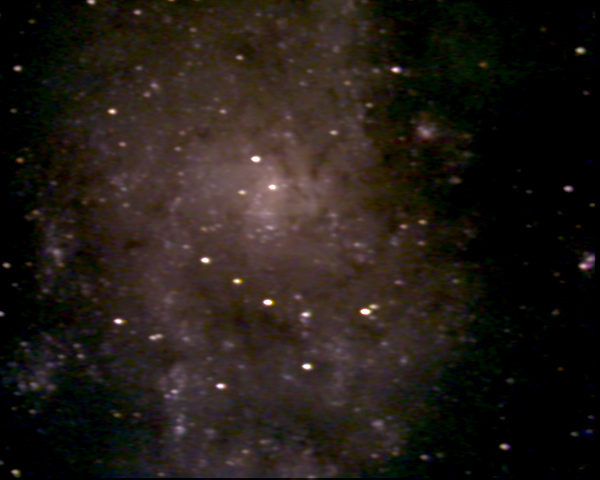
M33: Pinwheel Galaxy (core)

RA: 01hr 33m 54s Dec: 30º 39' 00", Mag: 5.7 Distance: 2.4 million light-years Constellation: Triangulum
This photo was taken on the 5th of October 2006 with the moon past its 1st quarter and therefore bathing the clear night sky with its opaque glow. Nevertheless, I was able to get this picture of the central portion of the loose Sc spiral of M33, the third of our local group of galaxies (Andromeda and our own Milky Way making up the other two). Again, the same problem as NGC7000, even at f3.3, the field of view of the Meade DSI is simply not large enough to incorporate the entire galaxy in one frame - the galaxy has two main arms which extend, one to the top left of the frame and the other to the bottom right, which is why this picture shows very little of the circular motion associated with galaxy forms - you're not seeing all of it.* The vertical dimensions of the galaxy are the equivalent of the diameter of 2 moons. The more I use the DSI, the more I am aware of its optical limitations and its shortcomings compared with photographs taken on film with SLRs or more expensive digital cameras with higher resolution. Nevertheless, it can demonstrate at the core nebulosity of M33, HII regions, star-forming densities and dust lanes.
Two sets of exposures were combined with Maxim DL to produce this finished image, the first consisting of 32x30 second exposures and the second, 42x30 second exposures making a cumulative exposure time of 37 minutes. The original composite had a green cast - for some reason, DSI was making a lot of green 'dark noise' which consecutive stacking of the 30 second exposures began to cancel out but never completely removed. The first step in the processing was to adjust the dark level to see if I could remove some of the green noise. This was carried out in the levels command of Photoshop 7 in the RGB channel. Following this, the green specifically in the background was reduced using the curves command taking care not to turn the picture too red/mauve. Midtone enhancement was carried out without any layer mask. No blur or sharp filters were applied. This picture, of all those in the archive, has had the least amount of processing.
* Since writing this I have been able to take a wide-field shot of M33 which you can see, for comparison, not just in the aspect difference, but how different processing of the image changes what details are revealed. The image page is visible by clicking HERE.
HOME PICTURES: Deep Sky PICTURES: Solar system PICTURES: Wide field